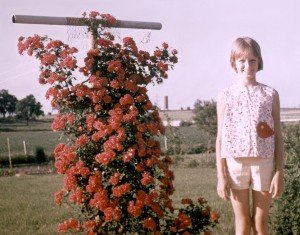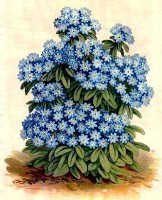
Val posing with climbing rose,
Manhattan, Illinois, 1968
When I was growing up in Illinois, I took plants for granted. We had vegetable gardens, wildflower beds, and plenty of other plants of all sorts. Hikes in the woods gave us a chance to enjoy spring blossoms, lush summer growth, and beautiful autumn colors. Of course, there was that completely different season, winter, in which everything went dormant, blanketed in snow and ice, but that has enough possibilities for another complete essay. Although the plants surrounded us, I took much more interest in animals and considered botany and horticulture to be rather boring.
 Val posing with climbing rose, Manhattan, Illinois, 1968 |
Luckily, as we grow older, we seem to find a deeper appreciation for, and develop more interest in, the varied aspects of our world. Only a couple years after moving into our current house, I discovered the joys of gardening. I think that an interest in photography developed at the same time and the two avocations fed one another. It had been a number of years since I'd left home, but I had been preoccupied with college and had been renting, usually in apartments. As I got back to enjoying a yard of our own, there were miles of difference (about 1200, actually) in what I remember from my youth and what I encountered here in Austin.
I have managed to adapt rather well to this hot, dry climate, and now cultivate a whole range of plants that I never could have grown in Illinois. But that doesn't mean that I don't sometimes long for those familiar flowers and delightful plants I enjoyed so much when I was a kid.
In one area, I'll have to admit defeat. The challenge of growing vegetables here, with the intense heat, dry clay soil, and unfamiliar plant diseases and pests, has been too much, and I don't try anymore. A large number of people do enjoy growing food plants, but adjusting to the difference from what I grew up with is just a bit too daunting for me. The soil in Illinois was rich and easy to dig in. The only disadvantage was the short growing season, having to wait until the frozen ground thawed and the sun was high enough in the vernal sky to germinate seedlings. We had ways, though, of dealing with that. We often started seeds in the house, on a glass-windowed porch, or in our cold-frame, a wooden box set into the ground with a glass pane cover. Our gardens produced all kinds of fruits and vegetables that I adored. Strawberries were simple to grow and the fruit was big and juicy. There were also wild strawberries available for the picking in some of the local forest preserves: tiny and intensely sweet. I loved the raspberries, mulberries, gooseberries, and apples. We grew several raspberry shrubs along a fence and it was impossible to pick enough to satisfy our whole family, especially when it was all too easy to eat as many as we saved.

Some vegetables grew just as well in the wild as in a garden (or better). Mushrooms, although not a plant, were one of our staples at meals and we ate them just like vegetables. Since they only grew in the fall, we had to stock our freezer during the mushroom hunting season with a year-long supply. Asparagus grew along the roads and I'd sometimes find tomatoes growing along rivers, where seeds had just managed to find a perfect spot. We grew carrots, radishes, several varieties of tomatoes, sweet corn, kohlrabi, Brussels sprouts, cauliflower, broccoli, potatoes, peas, and even pumpkins and watermelon.
While the food plants were nice, the flowers are the thing I miss the most. My all-time favorite smell is produced by the lily-of-the-valley. This little bulb was easy to grow in shaded areas along the house, back behind some evergreen shrubs. I would sometimes pick a single flower stem to keep in a small jar of water in my room so I could smell it. I thought I might be able to try growing them here in Austin, if I put them on the north side of the house, with the ferns. When I asked about the bulbs at a local nursery, nobody working there knew what I was talking about! They knew about hundreds of southern plants, but had no idea what a lily-of-the-valley was. I felt like I was in a foreign country. To me, they were as commonplace as tulips, lilacs, and peonies. Of course, these other plants don't grow around here either.

Lilacs were one of those plants that were so common I didn't think about how much I liked them. As kids, we used to hold a flower cluster in our hands, like grapes, and revel in the scent. From white to deep purple, the colors were delightful, and the tiny flowers were fascinating, but the smell was enchanting.
There was a particularly lovable plant that grew by my paternal grandparents' house. The snowball shrub had large round clusters of pure white blossoms, obviously shaped like huge snowballs. I've never seen that plant anywhere else, but we used to love playing with the flowers when visiting there.
Another plant that I don't think I've ever seen grow around here is the peony. These are one of the messiest flowers because the blossoms are so heavy that they always fall all over the place. The buds are enormous and were always covered with ants. Somebody told me that, without the ants constant motion over the buds, they wouldn't open. I didn't really believe it.

I would feel right at home walking through an early spring forest, with the ground literally carpeted with spring beauties, bluebells, trilliums, mayapples, and columbines.
Other flowers do grow here as well as up north, but with much more limited success. Irises are quite popular but they always look small and undernourished compared to the five-foot tall plants covered with blossoms that grow easily without any additional care in a cool, wet climate. Moss rose used to flourish and reseed itself with no help from us. Tulips of all sorts were a joy because they would bloom every year, without the need to dig up the bulbs and refrigerate them. There was nothing quite so cheery as seeing purple crocuses poking up through the snow, the first flowers to bloom in the spring.  We had purple clematis that just covered an entire trellis with blossoms and roses that never appeared to be heat-stressed. Bleeding hearts, tiger lilies, bloodroot, and Jack-in-the-pulpit were all crammed into our crowded gardens, along with annuals like pansies, snapdragons and poppies. I even miss the annual battles with the dandelions, which grew as well in our lawn as did the grass. It was a pleasant chore to pull them up, one by one, their bright yellow flowers blazing in the sunshine. The few dandelions in our yard here in Texas are treated to wildflower status and carefully transplanted into the gardens.
We had purple clematis that just covered an entire trellis with blossoms and roses that never appeared to be heat-stressed. Bleeding hearts, tiger lilies, bloodroot, and Jack-in-the-pulpit were all crammed into our crowded gardens, along with annuals like pansies, snapdragons and poppies. I even miss the annual battles with the dandelions, which grew as well in our lawn as did the grass. It was a pleasant chore to pull them up, one by one, their bright yellow flowers blazing in the sunshine. The few dandelions in our yard here in Texas are treated to wildflower status and carefully transplanted into the gardens.
There are probably numerous flowers that I have forgotten. It's been a couple decades since I've spent much time up in Illinois. In the meantime, I've come to adore cactuses, semi-tropicals, and the many different species of wildflowers that grow for us here in Texas. However, if I someday live in a climate similar to northern Illinois again, I am sure I can readjust my gardening habits. After all, one can't possibly forget a forget-me-not.